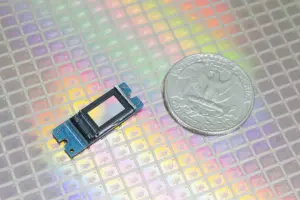Raontech is a Korean company targeting the augmented reality (AR) device market. At the beginning of this year, the company announced the development of a microdisplay with a resolution of 12,000 pixels per inch (PPI) using a liquid crystal on silicon (LCoS), a combination of liquid crystal display (LCD) and semiconductor processes to create ultra-fine pixels on a silicon wafer. Raontech also said that it had already secured over 200 customers, including those in the AR devices, medical solutions, and optical communication sectors.

Raontech’s microdisplay technology has also been integrated into the Qualcomm AR glass reference model, which serves as a guideline for AR device manufacturers. The reference model was released in conjunction with Qualcomm’s announcement of the Snapdragon AR2 AR semiconductor chip.
So, it isn’t very surprising when the company’s CEO, Brian Kim, tells The Elec that LCoS is superior to LED on silicon (LEDoS), contrary to the opinions of most experts. Kim argues that for AR glasses to be transparent like regular glasses, a bright display is required. LCoS can utilize MiniLEDs with 3 million nits in brightness, which translates to around 3,000 nits (1% through the waveguide) reaching the wearer’s eyes. In contrast, LEDoS experiences a significant drop in efficiency when reducing LED size to micrometer scale, resulting in a decrease in brightness. Kim believes that OLED on silicon is not suitable for AR glasses, offering only thousands of nits and having limitations in brightness.
Kim’s perspective challenges the prevailing belief that LEDoS is more optimal for AR devices. He highlights the need for a highly bright display to enable wearers to view the outside world while wearing AR glasses. Overcoming the brightness issue in LEDoS technology is expected to require substantial time for development. Additionally, Kim suggests that OLED on silicon may be more suitable for mixed reality (MR) goggle-type devices rather than thin and portable MR glasses.

